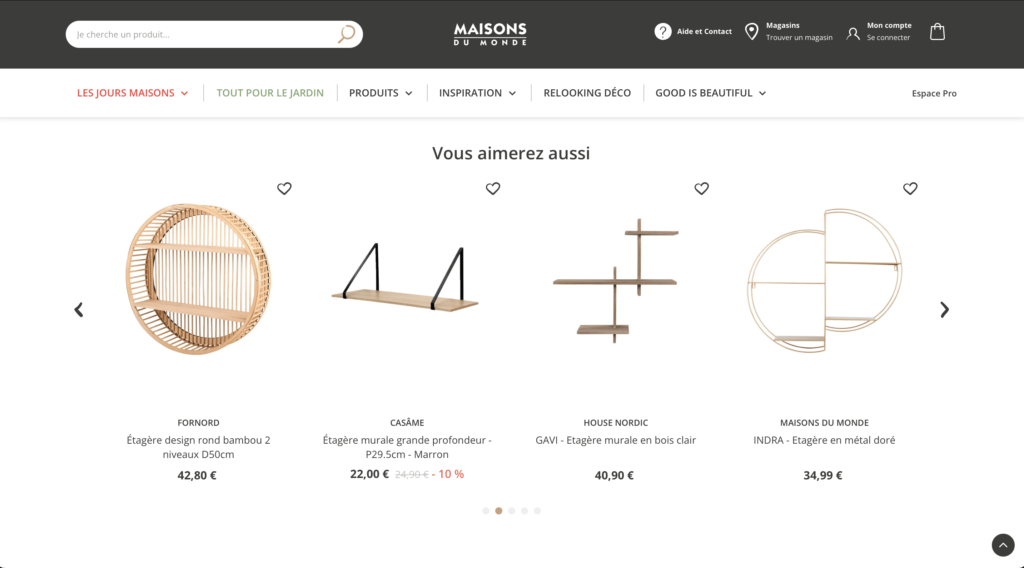In the US, the total e-commerce sales for 2022 were estimated at $1,034.1 billion, an increase of 7.7% from 2021, while in the UK, the most lucrative e-commerce market in Europe, we have observed nearly 60 million e-commerce users in 2022. And, as is often the case, increased demand has gone along with increased supply. So, how do you make your e-commerce website stand out?
1. Use the funnel technique
How do you make your e-commerce website stand out from the competition? Online traders often ask themselves this, particularly in the most influential sectors like tourism and fashion.
Our first tip is to use the funnel technique.
This marketing tool has six conversion stages for clients to go through:
- Awareness
- Interest
- Consideration
- Action
- Sale
- Loyalty
At each stage, you need to have solutions ready to attract the client to the next one. For example, at the awareness stage, the aim is to make yourself known to your target. You could post LinkedIn surveys to reach them and create an initial connection.
However, the action stage is entirely different. At this point, prospects already know your brand (very) well. There is just one step before they buy. So, this stage is about pushing prospects to visit your online store or physical store to buy your products.
To help future clients take this step, you can:
- Offer a X% discount (you decide how much)
- Create a feeling of urgency by putting a discount with a countdown timer on your homepage
- Set up a waiting list for out-of-stock products (and email out notifications when the correct size is back in stock)
- Add client reviews to product descriptions
- Feature relevant calls to action (CTAs) in strategic places (e.g., in blog posts)
2. Attract qualified visitors
If you attract qualified visitors, you will stand out from your competitors who only try to attract any kind of visitor without targeting them.
Here are some techniques you can use to attract qualified visitors:
- Write for sites and blogs in your own sector (or a similar one)
- Post SEO-friendly articles on your blog
- Launch an affiliate programme
- Advertise on Facebook Ads and Google Ads
- Organise events (on and offline)
- Analyse visits to your website and adjust your strategy (e.g., if Instagram is a key traffic source, you can step up your activity on it), etc.
3. Boost visitor confidence
Consumers won’t buy if they don’t trust you, but it can be a major challenge to create a sense of trust online. According to a study by IFOP, a polling and market research firm, 63% of internet users would not buy a product from a store they do not know.
Another interesting fact: men think a site’s reputation is more important than women do (66% among men vs 60% among women).
To boost visitor confidence, make sure your site has an SSL certificate. Write high-quality product information and have it translated by a professional. Offer a flexible return and exchange policy and be available by phone to answer client questions (you can also provide FAQs). Finally, add social proof to your website:
- Client reviews
- Evaluations
- Scores out of 5
- Photos of previous client purchases (on product information pages)
4. Personalise the client experience

Consumers need more and more recognition. To keep them satisfied, it’s important to create personalised buying experiences, especially for new visitors.
You can use artificial intelligence tools to analyse KPIs like consumption patterns and user behaviour.
Using this information, you can offer dynamic content. This means each person who arrives on your website will see different content.
Content Marketing principles say dynamic content should change based on timings and user interactions. For example, have a pop-up with a 10% off welcome discount show on the homepage when a prospect visits your site for the first time.
5. Increase your acquisition channels
By increasing your acquisition channels, you can diversify traffic acquisition for your e-commerce site. You will also stand out from your top competitor!
Here are the traffic acquisition sources you can try:
- Online review sites
- Social media (TikTok, Facebook, Instagram, LinkedIn, Twitter, etc.)
- Hyperlocal SEO
- Newsletters, email campaigns and translated marketing emails
- Relevant contributions to forums, blogs (comments) and social media (e.g., Facebook groups)
- YouTube videos (unboxings, tests, FAQs, tutorials, etc.)
- Influencers
6. Reduce basket abandonment
According to a recent study, 70% of online baskets are abandoned before a purchase. There are many reasons for this: indecision, high prices, excessive delivery charges, slow websites, missing payment methods, etc.
But what can you do to avoid it?
To make sure your prices are competitive, do some market research.
This will tell you:
- What your competitors’ prices are
- What payment methods they offer on their e-commerce sites
- What their shipping costs are
- What their returns policies are
- Which of their pages are most popular…and more!
This data will enable you to adapt your prices and offerings to become more competitive.
7. Have a subscription system
If your products are items your clients need regularly (e.g., toothpaste, dog food, web hosting, etc.), it might be useful to provide a reduced-cost subscription system.
A subscription system is an excellent way to boost your conversions.
For example, on the product page, you can show the normal price and the subscription price (with the reduction in bold). Another example: offer free delivery for any three-month subscription.
The result? Less work for you and client loyalty guaranteed for the length of the subscription.
8. Recommend personalised products

Ever heard of behavioural data?
This marketing data is very handy for targeting your product recommendations. As in this photo, you can display products that users may like. To do this, use client activity, both on and offline, to assess their actual needs more effectively.
Tools like Nosto and Clarity help you analyse the behaviour of your e-commerce site users. Using these tools, you can easily highlight products that are popular regionally and/or products previously viewed.
9. Answer user questions quickly
Being kind and polite is one thing, but answering the phone and emails fast is another, and it’s key.
By providing a quick client experience, you will stand out from your e-commerce competitors. Consumers (whether or not they’re ready for action) want instant responses to their questions. Therefore, adding live chat to your online store can be worthwhile, especially if your clients regularly ask you questions.
10. Implement an effective SEO strategy
Our final tip for standing out from the e-commerce competition is: use a concrete SEO strategy. Being number one on Google is one of the 10 e-marketing trends you need to know about.
To achieve this, you should:
- Publish blog posts regularly and often
- Limit sentence length (ideally under 15 words each)
- Use internal links to connect your blog posts
- Use the right keywords
- Introduce a backlinks strategy
- Use guest blogging
- Make sure your site’s UX is smooth
- Analyse your results and adjust as needed
How to make your e-commerce website stand out: a recap
As we’ve seen, there are lots of ways to stand out from your competition. The most obvious is to price competitively, but it’s far from alone.
You can win points by:
- Using the sales funnel technique
- Having an SSL certificate and comprehensive product information
- Targeting your prospects more effectively
- Personalising the client experience
- Increasing your acquisition channels
- Making your return and exchange policies more attractive
- Having a subscription system
- Recommending personalised products
- Responding quickly by phone and email
- Having a concrete SEO strategy
So, which tool are you going to use? If it’s the last one, discover the top 9 most common SEO errors (definitely to be avoided).







